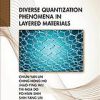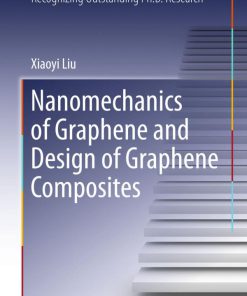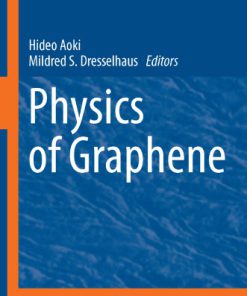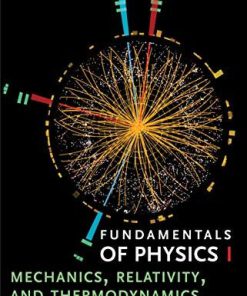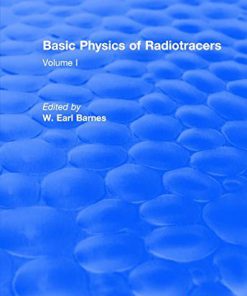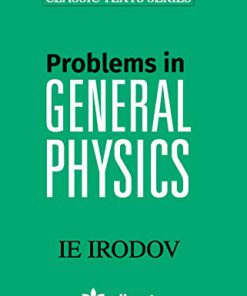The Physics of Graphene 2nd Edition by Mikhail Katsnelson 1108471641 9781108471640
$50.00 Original price was: $50.00.$25.00Current price is: $25.00.
The Physics of Graphene 2nd Edition by Mikhail I. Katsnelson – Ebook PDF Instant Download/DeliveryISBN: 1108471641, 9781108471640
Full download The Physics of Graphene 2nd Edition after payment.
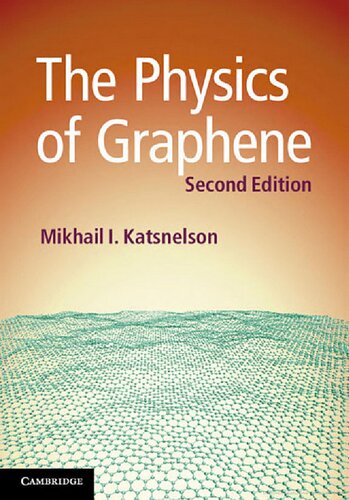
Product details:
ISBN-10 : 1108471641
ISBN-13 : 9781108471640
Author: Mikhail I. Katsnelson
Leading graphene research theorist Mikhail I. Katsnelson systematically presents the basic concepts of graphene physics in this fully revised second edition. The author illustrates and explains basic concepts such as Berry phase, scaling, Zitterbewegung, Kubo, Landauer and Mori formalisms in quantum kinetics, chirality, plasmons, commensurate-incommensurate transitions and many others. Open issues and unsolved problems introduce the reader to the latest developments in the field. New achievements and topics presented include the basic concepts of Van der Waals heterostructures, many-body physics of graphene, electronic optics of Dirac electrons, hydrodynamics of electron liquid and the mechanical properties of one atom-thick membranes. Building on an undergraduate-level knowledge of quantum and statistical physics and solid-state theory, this is an important graduate textbook for students in nanoscience, nanotechnology and condensed matter. For physicists and material scientists working in related areas, this is an excellent introduction to the fast-growing field of graphene science.
The Physics of Graphene 2nd Table of contents:
1 The electronic structure of ideal graphene
1.1 The carbon atom
1.2 π States in graphene
1.3 Massless Dirac fermions in graphene
1.4 The electronic structure of bilayer graphene
1.5 Multilayer graphene
2 Electron states in a magnetic field
2.1 The effective Hamiltonian
2.2 Landau quantization for massless Dirac fermions
2.3 Topological protection of the zero-energy states
2.4 Semiclassical quantization conditions and Berry’s phase
2.5 Landau levels in bilayer graphene
2.6 The case of bilayer graphene: trigonal warping effects
2.7 A unified description of single-layer and bilayer graphene
2.8 Magnetic oscillations in single-layer graphene
2.9 The anomalous quantum Hall effect in single-layer and bilayer graphene
2.10 Effects of smooth disorder and an external electric field on the Landau levels
3 Quantum transport via evanescent waves
3.1 Zitterbewegung as an intrinsic disorder
3.2 The Landauer-formula approach
3.3 Conformal mapping and Corbino geometry
3.4 The Aharonov–Bohm effect in undoped graphene
4 The Klein paradox and chiral tunneling
4.1 The Klein paradox
4.2 The massless case: the role of chirality
4.3 Klein tunneling in single-layer graphene
4.4 Klein tunneling for a smooth potential barrier and the effect of magnetic fields
4.5 Negative refraction coefficient and Veselago lenses for electrons in graphene
4.6 Klein tunneling and minimal conductivity
4.7 Chiral tunneling in bilayer graphene
5 Edges, nanoribbons, and quantum dots
5.1 The neutrino billiard model
5.2 A generic boundary condition: valley mixing
5.3 Boundary conditions for a terminated honeycomb lattice
5.4 Electronic states of graphene nanoribbons
5.5 Conductance quantization in graphene nanoribbons
5.6 The band gap in graphene nanoribbons with generic boundary conditions
5.7 Energy levels in graphene quantum dots
5.8 Edge states in magnetic fields and the anomalous quantum Hall effect
5.9 Spectral flow for massless Dirac fermions
6 Point defects
6.1 Scattering theory for Dirac electrons
6.2 Scattering by a region of constant potential
6.3 Scattering theory for bilayer graphene in the parabolic-band approximation
6.4 General theory of defects in a honeycomb lattice
6.5 The case of vacancies
6.6 Adsorbates on graphene
6.7 Scanning tunneling microscopy of point defects on graphene
6.8 Long-range interaction between adatoms on graphene
7 Optics and response functions
7.1 Light absorption by Dirac fermions: visualization of the fine-structure constant
7.2 The optics of Dirac fermions: the pseudospin precession formalism
7.3 Many-body corrections to the universal optical conductivity: a phenomenological approach
7.4 The magneto-optics of Dirac fermions
7.5 Optical properties of graphene beyond the Dirac approximation
7.6 The dielectric function of Dirac fermions
7.7 Static screening
7.8 Plasmons
7.9 Transverse response functions and diamagnetic susceptibility
8 The Coulomb problem
8.1 Scattering of Dirac fermions by point charges
8.2 Relativistic collapse for supercritical charges
8.3 Nonlinear screening of charge impurities
8.4 Interelectron Coulomb interaction and renormalization of the Fermi velocity
9 Crystal lattice dynamics, structure, and thermodynamics
9.1 Phonon spectra of graphene
9.2 The theory of elasticity for thin plates
9.3 The statistical mechanics of flexible membranes
9.4 Scaling properties of membranes and intrinsic ripples in graphene
9.5 The self-consistent screening approximation
9.6 Thermodynamic and other thermal properties of graphene
9.7 Mechanical properties of graphene
9.8 Raman spectra of graphene
10 Gauge fields and strain engineering
10.1 Strain-induced pseudomagnetic fields
10.2 Pseudomagnetic fields of frozen ripples
10.3 Pseudomagnetic fields of ripples: the effect of in-plane relaxation
10.4 The zero-field quantum Hall effect by strain engineering
10.5 The pseudo-Aharonov–Bohm effect and transport gap in suspended graphene
10.6 Gap opening by combination of strain and electric field
11 Scattering mechanisms and transport properties
11.1 The semiclassical Boltzmann equation and limits of its applicability
11.2 The Kubo–Nakano–Mori formula for resistivity
11.3 Scattering mechanisms in graphene on a substrate
11.4 Intrinsic mobility and transport properties of suspended graphene flakes
11.5 Edge scattering of electrons in graphene
11.6 Nonlocal transport in magnetic fields
11.7 Beyond the Boltzmann equation: localization and antilocalization
11.8 Hydrodynamics of electron liquid in ultra-pure graphene
12 Spin effects and magnetism
12.1 General remarks on itinerant-electron magnetism
12.2 Defect-induced magnetism in graphene
12.3 Magnetic edges
12.4 Spin-orbit coupling
12.5 Spin relaxation due to edge scattering
13 Graphene on hexagonal boron nitride
13.1 Motivation: ripples and puddles
13.2 Geometry and physics of moiré patterns
13.3 Zero-mass lines and minimal conductivity
13.4 Berry curvature effects
13.5 Electronic structure of moiré patterns
13.6 Magnetic bands in graphene superlattices
14 Twisted bilayer graphene
14.1 Geometry and atomic structure
14.2 Dodecagonal graphene quasicrystal
14.3 Electronic structure of twisted bilayer graphene
15 Many-body effects in graphene
15.1 Screening and effective interactions
15.2 Mapping onto the Hubbard model
15.3 Renormalization of the electron spectrum beyond Dirac approximation
15.4 Quantum Monte Carlo results
15.5 Many-body renormalization of minimal conductivity
People also search for The Physics of Graphene 2nd:
why is graphene important
dangers of graphene
the graphene
the physics of gravity
the future of graphene
Tags: The Physics, Graphene, Mikhail Katsnelson, graphene physics
You may also like…
Mathematics
Housekeeping & Leisure - Games: Chess
The Method of Preparing for Competition 2nd Edition by Mikhail Botvinnik ISBN 9798630282347
Computers
Physics
Fundamentals of Physics I Mechanics Relativity and Thermodynamics 2nd Edition Ramamurti Shankar
Politics & Philosophy - Anthropology
Physics - General Courses


